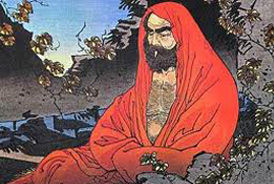There has been much hype and hoopla surrounding the latest movie to hit the theatres this Diwali in Tamil- Yezhaam arivu.
The multi crore budget movie has been marketed well and the expectations it has created has raised many eyebrows, including this movie buff. The story of Bodhi Dharma is by itself very intriguing- a Pallava Prince turned Buddhist monk of the sixth century. The Father of Chan ( zen) Buddhism and the man who named ‘tea’ from TAI…Fondly called Daruma in Japan and Da Mo – “ the blue eyed barbarian” in Chinese. When Chan spread from China to Japan, the myth of Bodhi Darma too sailed across to Japan. Today traditional Daruma dolls are an essential ficture in every Japanese home. Every monastery in China houses his statue. Bodhi Dharma is also said to have propagated the mix of yoga, silambattam, varmakalai and Indian martial arts and existing Chinese martial art forms to the Shaolin monks at the world renowned Shaolin Temple. He is father of Shaolin Arts- that reshaped into modern day’s kung- fu!
 |
| Oldest painting of Bodhi Dharma from 12th Century, Japan. Courtesy- onmarkproductions.com |
Tanlin, the Chinese scholar of the sixth century mentions Bodhi Dharma in his book-
“The Dharma Master was a South Indian of the Western Region. He was the third son of a great Indian king of the Pallava Dynasty. His ambition lay in the Mahayana path, and so he put aside his white layman’s robe for the black robe of a monk. Lamenting the decline of the true teaching in the outlands, he subsequently crossed distant mountains and seas, traveling about propagating the teaching in Han and Wei.” This is the first ever mention we find of Bodhi Dharma in China.
Prof Tsutomu Kambe – Univ of Tokyo provided an answer to his birth – “Documents published just after Tang dynasty (ending in 907) describe that the name of the Kingdom of Bodhidharma’s origin as expressed with two Chinese characters ’香至. A likely pronunciation is Kang-zhi (Kanchi).” Various accounts say Bodhi Dharma was born the third prince of Pallava King, who followed Buddhism under the able guidance of his master Pragnyadhara. This is again a slight variation from Gautam Buddha, narrates Osho- “he was not averse to initiate women as sanyasins like Gautam Buddha- he himself was a disciple of Sanyasin Pragnyadhara”! It was Pragnyadhara who prodded him to move on to China. It was her unabated streamlining that made him shed all his material love . He followed his master’s orders to reach China- the land of Zhen Dan. He probably sailed to China- a proof to again show the Indian Kings had naval prowess and crossed to mainland China by crossing the Yangtze River. The interesting interpretation of his crossing the Yangtze by using a reed, not a boat, depicts the smooth sailing of Dharma over the turbulent waters of samsara!
 |
| Bodhi Dharma, crossing Yangtze on a reed- courtesy xabusiness.com |
He practiced a unique form of yoga- zazen in Japanese, his own style- the ‘wall gazing’. He is referred to as the ‘wall gazing monk’. That may be a method of finding the truth behind a wall- the mind…This was definitely not meditation. Every monastery in China and Japan boast of a statue of Bodhi Dharma, but Indian history has no trace of him. He himself had to relinquish worldly interests including the Pallava throne to spread Buddhism which was almost extinct by then, with the re-emergence of Hinduism. His death and fag end of his life is also shrouded in mystery. Legend says he was poisoned and died. He was buried, but a Chinese official named Shung Yun who knew him, saw him alive after three days heading towards India, barefoot, with a sandal in his hands. When enquired, Bodhi Dharma answered he was returning to India once for all and moved on. Only when the Chinese official returned home did he know that Dharma had been dead for three days. His tomb was immediately dug out and all they could find was a single sandal. His corpse was missing…History talks volumes of Jesus’ resurrection, but there is no hint of Dharma’s death and awakening. He simply vanished in thin air.
|
Daruma eye painting- at the beginning of the year and the end. |
 |
| Prince Charles painting a Daruma doll’s eye!
Pic Courtesy- carpages.co.uk |






















































